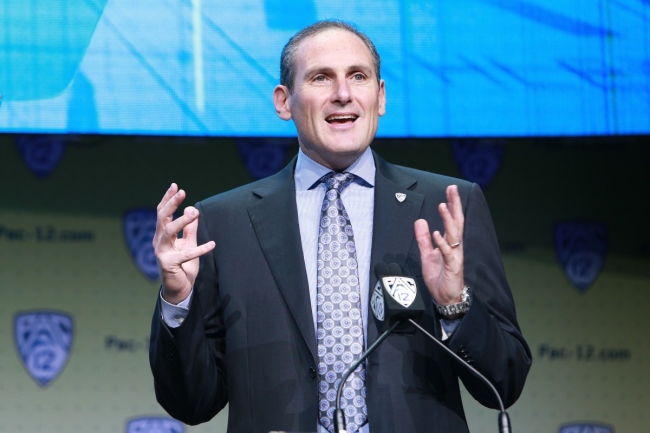You have /5 articles left.
Sign up for a free account or log in.

Pac-12 Commissioner Larry Scott
Getty Images
In the last year, the Pacific-12 Conference -- one of the country's best-known sports brands, whose members have won more national championships than any other league -- has continued its multiyear decline.
Its member universities have had a lackluster showing in the most lucrative college sports, football and men’s basketball. And Pac-12 presidents and athletics leaders have complained about not keeping financial pace with the conference’s peers like the Big Ten and Southeastern Conferences, which are sharing significantly more revenue with their institutions.
That gap has apparently led to an unprecedented proposal: consolidating some of Pac-12’s assets and then selling a piece of that new entity to private investors.
Industry experts question whether the plan, which was first reported by The Oregonian, could succeed given the complexity in managing both a nonprofit (the conference) and a separate for-profit entity.
The conference's leaders, the presidents and chancellors of the member universities who oversee the league's commissioner and other employees, have discussed the pitch twice with Commissioner Larry Scott, the newspaper reported. Under the plan, some of the Pac-12's most commercial assets -- broadcast and sponsorship rights, merchandising and more -- would be spun off into a unit called Pac-12 NewCo, 10 percent of which would be offered to investors for an estimated $500 million.
That cash infusion would immediately be distributed among the member colleges and universities, which are based in the West. The conference would still retain 90 percent of the equity in NewCo.
“Pac-12 NewCo. sounds interesting, but I doubt the plan will work … or attract investors,” said John Vrooman, a sports economist and professor at Vanderbilt University.
The Pac-12 officials valued NewCo at between $5 billion and $8.5 billion, but they are making some assumptions: that they'd receive significant revenue from DirecTV ($36 million annually), a total $2 billion deal with Fox and a $347 million payment from ESPN, none of which have been confirmed yet. They were making these estimates based off current media rights deals and other "conservative" estimates.
A Pac-12 spokesman, Andrew Walker, said in a statement to Inside Higher Ed, "As the value of Pac-12 media assets has continued to grow significantly over the years, we regularly evaluate proposals we receive and consider strategic options to maximize value for and with our members. As a matter of policy, we do not comment publicly on the nature of these discussions."
This deal is unsurprising, said Marcus Owens, a partner at the Washington law firm Loeb & Loeb. He previously worked for the Internal Revenue Service and investigated nonprofits and commercial revenue as the IRS's Exempt Organizations Division director.
Universities for a while now have farmed out auxiliary services, such as dining or the bookstore, to outside companies in an attempt to maximize revenue, Owens said. This is the first occasion he knows of for an athletics conference possibly attempting it, he said.
Owens said the conferences have likely not tried it before because they enjoy tax exemption, so they have never needed to tap in to investors.
If the business activity of NewCo began to be blurred with the rest of the conference, such as if officials were assigned to the governing boards of both entities, it could create some problems, Owens said. He guessed that the leaders would try to ensure clear separation between the two groups.
“It’s an interesting expansion of an activity that has been trending for some time in higher education,” Owens said.
By and large, the Pac-12 has struggled in the last few years. Scott is a controversial figure for his desire to infuse the conference with glitz generally only seen among professional leagues. He insisted that the Pac-12 headquarters be located in pricey San Francisco, skyrocketing the rent to millions of dollars. His compensation is nearly $5 million, according to the most recent available tax filing, double that of Jim Delany, Big Ten Conference commissioner, despite Delany running the most prominent conference of the Power 5.
And Scott’s deal seven years ago to keep the Pac-12 TV network independent -- forgoing a partnership with a major media company such as Fox -- has often been cited as the reason for the conference’s money troubles. The Pac-12 has paid tens of millions of dollars to run its cable network, while the Big Ten’s costs are generally covered by its partnerships, such as one with Fox, which owns just more than half the network -- ESPN owns part of the SEC's network.
“In an arms race in these other conferences, Pac-12 has fallen short of late,” said David Carter, executive director of the Sports Business Institute at the University of Southern California.
In 2011, the Pac-12 did sell rights to its men’s basketball and football games to ESPN and Fox for a total of $3 billion over the course of 12 years, which at the time was the most lucrative deal among the college conferences. But its competitors locked in new deals that overtook the Pac-12’s, which was locked in to a rate until the arrangement expires in 2024. Conference officials have expressed confidence that the Pac-12 will catch up with its competitors in five years and that the league's value is increasing significantly.
In the meantime, the financial missteps have trickled down to the universities within the Pac-12, each of which received a share of about $31 million in fiscal year 2016. That may seem like a lot. But consider the other conference shares -- the Big Ten’s members each get $50 million, and the Southeastern Conference’s receive $41 million.
The total annual revenue of the Pac-12 is about $500 million.
Some of the Pac-12's athletics directors, football and basketball coaches, and presidents -- all generally among the highest-paid employees at sports-centric universities -- have been dissatisfied.
Both Ray Anderson, Arizona State University's athletics director, and Kirk Schulz, Washington State University's president, have said in interviews that the financial gaps between the Pac-12 and the other conferences have disadvantaged the universities. The institutions are hard-pressed to recruit top-tier players or build facilities, they said.
Other former athletics directors have talked publicly about how they felt Scott disregarded them or said they were silenced outright when they brought concerns to him about revenue.
In an interview with Sports Illustrated, Scott waved away issues of money.
“The focus on money is natural, but it’s only one piece of a broader equation that leads to competitive success,” Scott told the outlet. “Our conference has some significant non-financial advantages: the cities that we’re in, the universities, the academic excellence, the overall athletic excellence. California is in our backyard from a recruiting standpoint. We’re a conference that’s never been at the top of the standings in terms of revenue, but we’ve always been at the top of the standings in terms of winning. That’s what we measure. Having the most money, we’ve never had. We don’t need the most money to be competitive.”








